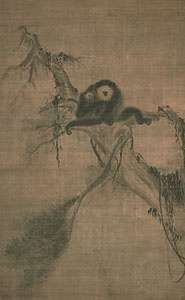Muqi Fachang
Chinese painter
Wade-Giles romanization Mu-hsi Fa-ch'ang
flourished 13th century, Sichuan province, China
 one of the best-known Chinese Chan (Chan painting) (Japanese: Zen) Buddhist painters. His works were influential in Japan.
one of the best-known Chinese Chan (Chan painting) (Japanese: Zen) Buddhist painters. His works were influential in Japan.Toward the end of the Southern Song dynasty (c. 13th century), Muqi found himself in political trouble and fled to a monastery near the capital city of Hangzhou. His paintings on Chan themes stimulated many copies in Japan; thus, it is there that paintings likely to be authentic works by Muqi are now found, though the Japanese painter Mokuan (Mokuan Reien) traveled to Muqi's monastery and is said to have received two of Muqi's seals from the abbot of the temple, making some paintings in Japan somewhat suspect. Muqi, like many other Chinese painters, painted a variety of subjects—including landscapes, flowers, still lifes, and more orthodox iconographic subjects. While there are various examples of each extant, indicating his diverse interests and styles, the most famous paintings associated with Muqi include Six Persimmons; a triptych with a white-robed Guanyin at the centre flanked on either side by a scroll of monkeys and a crane; and a surviving set of four sections of an original set of Eight Views of the Xiao and Xiang Rivers. However the paintings may vary in style and subject matter, there is throughout an appropriate sense of immediate vision and creation and a totally responsive hand, expressed with broad and evocative washes of ink.
- Henry Darwin Rogers
- Henry David Thoreau
- Henry Dearborn
- Henry de Bracton
- Henry Demarest Lloyd
- Henry de Montherlant
- Henry Deringer
- Henry Draper
- Henry Draper Catalogue
- Henry Dreyfuss
- Henry Drummond
- Henry Dumas
- Henry Duncan Graham Crerar
- Henry Dunster
- Henry Du Pré Labouchere
- Henry Edmund Holland
- Henry Edward Armstrong
- Henry Edward Manning
- Henry E. Huntington
- Henry Engelhard Steinway
- Henry Ernest Sigerist
- Henry Fairfield Osborn
- Henry Fielding
- Henry Fitzalan, 12th earl of Arundel
- Henry Fitzalan Arundel, 12th earl of